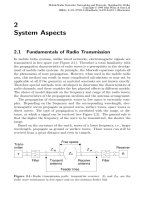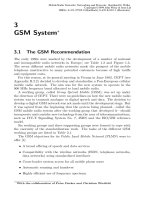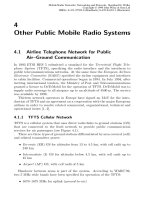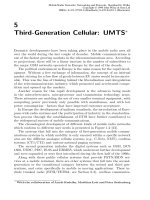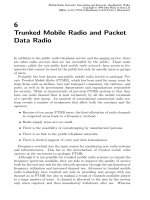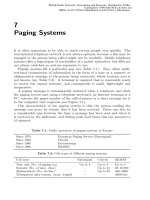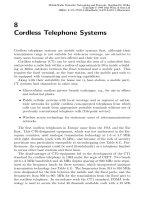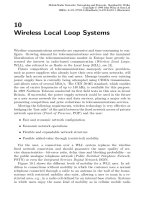Tài liệu Điện thoại di động mạng lưới Radio P5 ppt
Bạn đang xem bản rút gọn của tài liệu. Xem và tải ngay bản đầy đủ của tài liệu tại đây (950.04 KB, 43 trang )
5
Third-Generation Cellular: UMTS
∗
Dramatic developments have been taking place in the mobile radio area all
over the world during the last couple of decades. Mobile communications is
one of the fastest growing markets in the telecommunications area. According
to projections, there will be a linear increase in the number of subscribers to
the major GSM networks operated in Europe by the end of the decade.
The political environment in Europe is the main reason for the rapid devel-
opment. Without a free exchange of information, the concept of an internal
market striving for a free flow of goods between EU states would be inconceiv-
able. This was the line of thinking behind the liberalization and deregulation
of the telecommunications industry, which promoted and accelerated compe-
tition and opened up the markets.
Another reason for this rapid development is the advances being made
in the microelectronics, microprocessor and transmission technology areas.
These advances are enabling the use of ever smaller terminal equipment, with
computing power previously only possible with mainframes, and with low
power consumption—factors that have improved customer acceptance.
In Europe the development of uniform standards, the introduction of Euro-
pean-wide radio systems and the participation of industry in the standardiza-
tion process through the establishment of ETSI have further contributed to
the widespread success of mobile communications.
The chronological development of different kinds of mobile radio networks
which conform to different user needs is presented in Figure 1.2 [23].
The systems that fall into the category of first-generation mobile commu-
nications systems in which mobility is only ensured within a specific network
area are the different analogue cellular systems (e.g., C-Netz, NMT), cordless
systems (CT1/CT2) and various national paging systems.
The second generation includes the digital systems such as GSM, DCS
1800, USDC, PDC, IS-95 and ERMES, which underwent further development
and were expanded or were first introduced during the first half of the 1990s.
Along with these public cellular systems that provide PSTN/ISDN ser-
vices at a mobile terminal, there are other systems that fall into the second-
generation or the transitional category between the second and third gen-
erations, and cater specifically to mobile or moving applications. These in-
clude trunked radio (ETSI/TETRA, see Section 6.3), cordless communica-
∗
With the collaboration of Arndt Kadelka, Matthias Lott and Peter Seidenberg
Mobile Radio Networks: Networking and Protocols. Bernhard H. Walke
Copyright © 1999 John Wiley & Sons Ltd
ISBNs: 0-471-97595-8 (Hardback); 0-470-84193-1 (Electronic)
322 5 Third-Generation Cellular: UMTS
Networks
Core Transport
UIM: User Identification Module
TE: Terminal
Domain
Services
MBS
CATV
WAN
LAN
Application
Network Domain
Core Transports
Domain
Equipment
Terminal
UMTS
B-ISDN
ISDN
S-PCN
DECT
Networks
Access
UIM
UIM
Examples:
GSM
BSS
TE
TE
Fixed
Fixed
Mobile
TE
Mobile
TE
Examples:
GSM NSS + IN
ISDN/IN-based
B-ISDN + IN-based
TCP/IP-based
B-ISDN + TINA-based
Access Network Domain
Figure 5.1: Global multimedia mobility architecture
tions (ETSI/DECT, see Chapter 9, and the Personal Handyphone System,
PHS, see Chapter 11), local broadband communications (ETSI/HIPERLAN
1, see Section 13.1, IEEE 802.11, see Section 13.9), wireless ATM systems
(ETSI/BRAN, see Section 12.1.5), mobile personal satellite radio (IRIDIUM,
Globalstar, see Chapter 14) and other systems integrating aspects of these
systems.
Third-generation mobile radio systems, which use intelligent networks to
incorporate public mobile radio services that previously were operated sep-
arately, are already being developed today. Under the designation Global
Multimedia Mobility (GMM), ETSI is developing an architecture that defines
mobile radio networks as the access networks to an integral transport plat-
form that is based on broadband (B)-ISDN and provides mobility-supported
value-added services (see Figure 5.1). It is planned that these future standard
mobile communications networks (UMTS and FPLMTS or IMT 2000), which
aim to support the services of the terrestrial broadband ISDN, will lead to
a universal worldwide public mobile radio system, which is expected to be
operational by the year 2003.
The main characteristics of third-generation mobile radio systems are [1]:
5.1 UMTS (Universal Mobile Telecommunications System) 323
• Support of all features currently being offered by different systems.
• Support of new services with high quality of service, the same as in the
fixed network.
• High capacity, which will support high market penetration.
• High spectral efficiency.
• Lightweight, small (pocket-sized) and inexpensive handheld equipment
for mobile telephone use.
• High security, comparable to that of the fixed network.
High demands are being placed on the third-generation systems, e.g.:
• Services (voice and data, teleservices, bearer services, supplementary
services).
• Different bit rates (low bit rates for voice; data rates up to 2 Mbit/s).
• Variable bit rates and packet-oriented services.
• Use of different sized cells (macro, micro, pico) for indoor and outdoor
applications, with seamless handover between indoor and outdoor base
stations.
• Operation in non-synchronous base station subsystems.
• Advanced mobility characteristics (UPT, see Chapter 15; roaming, han-
dover, etc.).
• Flexible frequency management.
• Flexible management of radio resources.
5.1 UMTS (Universal Mobile
Telecommunications System)
In Europe work continues to be carried out on the development of a third-
generation mobile radio system called UMTS (Universal Mobile Telecommuni-
cations System) in the EU programmes RACE (1989–1994) (Research and De-
velopment in Advanced Communications Technologies in Europe) and ACTS
(1995–1998) (Advanced Communication Technologies and Services) in coop-
eration with ETSI. Work on UMTS is also being done in COST (European
Cooperation in the Field of Scientific and Technical Research) projects [20].
The technical subcommittee (STC) SMG 5 at ETSI has been given the
responsibility for producing the UMTS standard. Other SMG subcommit-
tees that are currently still working on the GSM 2+ standard will eventually
324 5 Third-Generation Cellular: UMTS
become involved in the standardization of UMTS, e.g., SMG 2. SMG 5 will
then take over the creation of the UMTS standard and the coordination of
the standardization activities. There is also the UMTS Forum, comprising
the European signatories to the UMTS–Memorandum of Understanding of
the Introduction of UMTS defined in 1996.
The main tasks of SMG 5 are [2, 15]:
• Study and definition of services, system architecture, the air interface
and the network interfaces for UMTS.
• Generation of basic technical documentation for UMTS.
• Coordination of ETSI and of SMG regarding UMTS.
• Cooperation and coordination with the ITU for the definition of a world-
wide standard on the basis of UMTS/FPLMTS/IMT 2000.
• Cooperation with European research programmes.
The aim of the UMTS concept is to provide users with a handheld terminal
that will cover all areas of application—at home, in the office, en route by
car, in a train, in an aircraft and as a pedestrian. UMTS will therefore offer
a common air interface that will cover all fields of application and have the
flexibility to integrate worldwide the different mobile communications systems
available today, such as mobile telephone and telepoint, trunked radio, data
radio, and satellite radio systems, into one system.
What will play an important role in UMTS is the concept of intelligent
networks (IN) that will provide call charging and mobility management for the
localization and routing of calls across networks operated by different service
providers and operators. UMTS will be the first system to offer mobile users
roaming during an existing connection, with handover between networks with
different applications and different operators [17].
UMTS will offer transmission capacity comparable to ISDN for services
such as video telephony and wideband connections, and will support the ser-
vice concept Universal Personal Telecommunications (UPT) [4]; see Chap-
ter 15. With UMTS it will be possible to transmit voice, text, data and
images over one connection, and subscribers will be assigned a personal tele-
phone number that will allow them to be reached anytime, anywhere in the
world.
The first series of standards for UMTS has been completed in March 1999.
The projection is that UMTS, which according to Appendix D will use the
frequency band between 1.885 and 2.2 GHz, will be introduced around 2003.
However, the UMTS Forum has a preference for the frequencies indicated
in Figure 5.2, staggered timewise as shown, and is promoting the refarming
of bands previously used for other purposes (see Appendix D) and working
towards including asymmetrical bands along with the symmetrical ones. The
planned frequency allocations to IMT 2000/UMTS are shown in Figure 5.3.
5.1 UMTS (Universal Mobile Telecommunications System) 325
300-500 MHz
UMTS Core Band
2110 MHz 2170 2200 MHz2025 MHz2000
+ 20 MHz
+ 15 MHz
Sat Sat
Year 2002: 2x30 MHz
Year 2005: 2x60 MHz
Year 2008: approx. 300
to 500 MHz
1900 MHz
e.g., Downlink
Licensed Licensed/Unlicensed Licensed
e.g., Uplink 60 MHz
95 MHz
Figure 5.2: UMTS frequency spectra, UMTS Forum’s perception of timetable for
development
MSS
Reg.2
MSS
Reg.2
Europe
Japan
USA
ITU/RR
MSS
MSS
MSS
MSS
IMT-2000
UMTS
IMT-2000
PCS
IMT-2000
MSS
MSS
MSSIMT-2000
UMTS MSSGSM 1800
PHS
UMTS
DECT
UMTS
1800 1850 1900 1950 2000 2050 2100 2150 2200 2250
Frequency [MHz]
Figure 5.3: Spectrum Allocation
Originally it was planned to specify one air interface only able to cover all
the different services and applications aimed at. From the decision made in
January 1998 (see Section 5.7.5), it is now clear that at least two air interfaces
will be specified—one based on paired bands with frequency division duplexing
(FDD) transmission, and another air interface operating in a single band with
time division duplexing (TDD) transmission.
Both standards will use DS-CDMA for radio transmission and channel
access, and are addressed as FDD-CDMA and TDD-CDMA systems respec-
tively. From the viewpoint of intellectual property right (IPR), there are still
those in Europe proposing to stay with F/TDMA as the basis for UMTS and
to make no use of CDMA, since QUALCOMM is the owner of some CDMA
key patents but is not willing to license their use under the so-called fair rules
326 5 Third-Generation Cellular: UMTS
established by ETSI. In fact, the EDGE proposal (see Section 3.11) submitted
by Ericsson to ITU-R is capable of providing wideband services compatible
to GSM 2+.
The main driving force towards UMTS at present comes from manufactur-
ers aiming to introduce new products into the market and operators aiming to
get under the label UMTS access to more bandwidth for voice services only.
Mobile data was still only a few percent of business in 1998. The European
Commission has issued guidelines for the licensing of UMTS bands to opera-
tors demanding that 50 % of the services offered should be data services for
multimedia applications.
The demand for more bandwidth can of course easily be covered by assign-
ing UMTS frequency bands to be used by GSM networks, and does not need
the introduction of a new air interface.
5.2 FPLMTS (Future Public Land Mobile
Telephone System); IMT 2000 (International
Mobile Communications at 2000 MHz)
In 1985 the CCIR (see Annex B.1.2) set up a working group, the Task Group
8/1 (previously IWP 8/13), for the purpose of specifiying all the requirements
and system parameters for a future public land mobile telecommunication
system (FPLMTS). The following requirements for an FPLMTS were drawn
up by the working group [5, 13, 19]:
• Small, lightweight handheld equipment.
• Worldwide use of terminal equipment, i.e., uniform frequencies world-
wide.
• Integration of different mobile radio systems and international roaming.
• Integration into the fixed telephone networks (ISDN compatibility).
• Integration of mobile satellite radio.
• Use of terminal equipment on land, in the air and at sea.
As with the UMTS, the aim with the FPLMTS is to integrate all existing
services (mobile telephony, cordless telephony, paging, trunked radio, etc.)
into one service. Many of the aspects of FPLMTS are the same as those of
UMTS; however, since the ITU activities are globally based, there are some
differences between the two systems. For example, FPLMTS defines several
air interfaces for dealing with the different requirements of densely populated
areas (e.g., in Europe) versus sparsely populated areas (third world countries)
[22]:
5.3 Services for UMTS and IMT 2000 327
• R1: radio interface between mobile station (MS) and base station (BS)
• R2: radio interface between personal station (PS) and personal base
station
• R3: radio interface between satellite base station and mobile earth sta-
tion (MES)
• R4: additional air interface for paging FPLMTS terminals
The plan is to use FPLMTS as a temporary or permanent substitute for
fixed networks in developing countries and in rural areas where it is not eco-
nomically feasible to set up fixed networks.
At W(A)RC 1992 a spectrum of 230 MHz in the frequency bands 1885–
2025 MHz and 2110–2200 MHz was allocated to the FPLMTS system world-
wide. These frequency bands were not exclusively reserved for FPLMTS, and
can also be used in other systems. So in Europe, for example, the lower part of
the allocated frequency band is occupied by GSM 1800 and the DECT system.
The UMTS Forum is now requesting that 500 MHz starting from 1900 MHz
be reserved for symmetrical and asymmetrical connections (see Figure 5.2).
The earliest date being envisaged for the operation of FPLMTS is sometime
between 2000 and 2005, the same as for UMTS. Since about 1995, FPLMTS
has often been referred to as IMT 2000, but both designations refer to the
same system operating around 2000 MHz.
5.3 Services for UMTS and IMT 2000
ETSI has published a preliminary list of services [10] that are to be supported
by UMTS and are based on the ITU-R/CCIR recommendations for FPLMTS
and the specifications of various European research projects of the RACE 2
programme. These UMTS-supported services are described below.
5.3.1 Carrier Services
UMTS should be able to support ISDN as well as broadband ISDN bearer
services. The following services are to be integrated [10]:
• Circuit-switched services:
– Transparent 64, 2·64, 384, 1536 and 1920 kbit/s with user data
rates of 8, 16 and 32 kbit/s
– Voice transmission
– 3.1, 5 and 7 kHz audio transmission
– Alternative voice or transparent data transmission with user data
rates of 8, 16, 32 and 64 kbit/s
328 5 Third-Generation Cellular: UMTS
• Packet-switched services:
– Virtual calls and permanent virtual channels
– Connectionless ISDN
– User signalling
Broadband (B) ISDN services with a transmission rate of 2 Mbit/s (so-
called wideband services) are also to be offered by UMTS to mobile users.
According to CCITT, these services will be classified as interactive or distri-
bution services.
Interactive services fall into the category of conversational services, message
services or interrogation services. Conversational services are implemented
through end-to-end connections, which can be either symmetrical bidirec-
tional, asymmetrical bidirectional or unidirectional. Message services offer
communication between users that is not time transparent. Interrogation ser-
vices are used for the inquiry and receipt of centrally stored data.
With distribution services information can be transmitted continuously
from one central location to any number of users, with the users unable to
influence the start or the end of a transmission. Another distribution service
offers users the possibility of influencing the start of the information trans-
mission.
Asynchronous Transfer Mode (ATM) was specified by ETSI as the trans-
mission technology for these B-ISDN services in the fixed (core) networks. In
order to derive requirements for the radio interface from the bearer services
being supported, ETSI, in accordance with the functional descriptions of B-
ISDN and the ATM adaptation layer (AAL) (see Section 12.2.4), divided the
bearer services into four classes [11]. These four classes of bearer services
differ from each other in their time responses, bit rates and types of con-
nection. Maximum bit ratio, maximum bit-error probability and maximum
delay time are specified within each class of bearer service for the different
communication scenarios.
5.3.2 Teleservices
The teleservices to be supported by UMTS are divided into three classes [10]:
1. Teleservices that already exist in the fixed network in accordance with
ITU-T/CCITT recommendations of the E, F and I series:
• Telephony:
– Voice
– Inband facsimile (tele-
fax groups 2 and 3)
– Inband data trans-
mission (using modem)
• Teleconferencing:
– Multiparty, added value
services
– Group calls
– Acknowleged group calls
– Multiple calls
5.3 Services for UMTS and IMT 2000 329
2. UMTS teleservices and applications, e.g.:
• Audio and video transmis-
sion
• Paging
• Broadcast services
• Database inquiries
• Data transmission
• Directory services (e.g.,
telephone book)
• Emergency call broadcasts
• Short-message services:
– Initiated by user
– Terminated by user
– Voice messages
– Facsimile
– Electronic mail
• Teleaction services (e.g.,
remote control)
• Mobility services (e.g.,
navigation or localization)
• Electronic mail
• Emergency calls
• Teleshopping
• Video monitoring
• Voice messages
3. The services with the largest need for bandwidth are multimedia (MM)
and interactive multimedia (IMM), such as data, graphics, images, audio
and video, and combinations thereof. With UMTS it should be possible
to use more than one of these media at the same time. Multimedia allows
the transmission of more than one type of information, e.g., video and
audio information. No further specifications exist yet for this service
[10].
5.3.3 Supplementary Services
In the standardization of supplementary services a differentiation has prin-
cipally been made between traditional non-interactive PSTN/ISDN services
and personalized interactive supplementary services. The service provider has
the option of making these services accessible to user groups or to individual
users. The following classes of supplementary services have been proposed in
accordance with the GSM and ISDN standards:
Number identification, e.g., abbreviated dialling, protection against undesir-
able calls, calling party identification
Call offering, e.g., call forwarding
Call termination, e.g., call holding
Multiparty communication, e.g., conference call
Group communication, e.g., communication in closed user groups
330 5 Third-Generation Cellular: UMTS
Billing, e.g., credit balance
Additional information, e.g., user-to-user signalling
Call rejection, e.g., blocking all incoming calls
A list of different service attributes is available in [10].
5.3.4 Value-Added Services
Personal mobility Using a smart card, subscribers are able to transfer their
telephone numbers to any terminal.
Virtual home environment (VHE) and service portability This allows the
users to set up their own personalized service portfolios and use them in
any other network. VHE emulates those services that are not actually
offered in the visited network, so that users notice nothing differently
from their own home network environments. Moreover, this is how the
preliminary UMTS services are provided.
Bandwidth-on-Demand This offers an efficient use of resources for services
that have heavily varying requirements for transmission bandwidth, such
as short-message services and video. Furthermore it allows users the
independent option of selecting between a higher bandwidth for a max-
imum quality of service or a lower bandwidth for more favourable costs.
5.3.5 Service Parameters
A service is characterized by different parameters, some of the most important
being:
• Net bit rate
• Symmetry of a service
• Usage level
• Coding factor
• Maximum bit-error ratio based on channel decoding
• Maximum delay allowed in data transmission
The net bit rate is the product of the average number of bits that have to
be transmitted within a certain period of time.
The delay parameter describes how long a waiting time is allowed in the
transmission of these bits. For example, a voice service requires a small delay
whereas a packet-data transmission has minimal requirements for the delay
times of individual packets. However, data transfer requires a considerably
lower bit-error ratio than a voice service, because the redundancy of the voice
codec can be fully utilized. A higher coding factor is needed for achieving a
5.3 Services for UMTS and IMT 2000 331
Table 5.1: Quality of service parameters
Service Call Data rate Residual bit- Delay [ms]
duration [kbit/s] error ratio
Telephony
– Voice 2 min 8−32 10
−4
40
– Teleconferencing 1 h 32−128 10
−4
40
Video telephony 2 min 64−384 10
−7
40–90
Video conferencing 1 h 384−768 10
−7
90
Message services
– SMS and paging cl 1.2−9.6 10
−6
100
(1.2−2.4 type)
– Voice mail 2 min 8−32 10
−4
90
– Facsimile mail 1 min 32−64 10
−6
90
– Video mail tbd 64 10
−7
90
– e-mail cl 1.2−64 10
−6
100
Distribution services tbd 1.2−9.6 10
−6
100
(2.4 type)
Database use tbd 2.4−768 10
−6
200+
Teleshopping tbd 2.4−768 10
−6
90
Electronic mail tbd 2.4−2000 10
−6
200
Message dist. cl 2.4−2000 10
−6
300
Tele-action services tbd 1.2−64 10
−6
100–200
tbd to be defined cl connectionless
lower bit-error ratio in order to protect data during transmission over a radio
channel.
The usage level parameter describes how often a connection is being used
to transmit data. For example, the usage level of a voice service is less than
0.5 because a user is generally either listening or speaking.
A service is also defined by its symmetry. This value determines which
bandwidth is required for a connection in one or the other direction. The voice
service is an example of a symmetrical service, because the same bandwidth is
used for both speaking and listening. Internet browsing (e.g., world wide web,
WWW) is a typical example of an asymmetrical service, because it requires
considerably less bandwidth for requesting than for receiving data. Table 5.1
lists the characteristics of some of the services.
5.3.6 Service-Specific Traffic Load
The effective service bandwidth can be calculated from the data of the ser-
vice parameters net bit rate, symmetry and coding factor [12]. The service
bandwidth describes the bandwidth used to provide a particular service.
The traffic generated by the use of a service is calculated by taking the
average duration of this usage and the frequency of usage. The effective call
332 5 Third-Generation Cellular: UMTS
duration T
eff
, which is calculated on the basis of the usage level N and the
average call duration T
call
, is produced as
T
eff
= N T
call
(5.1)
For the systems being planned, the frequency of usage of a service can
only be estimated. It is measured in BHCA (busy hour call attempts), and
indicates the average frequency of the usage of a service by a user during the
peak traffic hour.
If it is known which portion of the overall usage of services is an individ-
ual service then it is possible to calculate the effective bandwidth needed by
a user. The share of the service in the overall usage is then indicated with
the penetration D. The penetration varies with different operating environ-
ments (see Section 5.5.1). The traffic produced by a user utilizing a service is
calculated in Equivalent Telephony Erlang (ETE) [12]:
ETE
user
= T
eff
× BHCA × D ×
service bandwidth
telephony bandwidth
(5.2)
An ETE therefore corresponds to an Erlang of voice service with a transmis-
sion bandwidth of 16 kbit/s. This equation was used to produce an example of
the traffic load for voice telephony, video telephony and the facsimile service.
The throughput represents the speed at which the user data is transmit-
ted. This data quantity is increased by a constant factor through the coding
used for error detection and correction. Finally consideration must be given
to the form of symmetry. For example, with the telephony services data is
transmitted in both directions, whereas with the facsimile service it is mainly
in one direction.
5.3.6.1 Voice Telephony
Voice telephony is a symmetrical service with a usage level of 0.5 or less. The
net bit rate of the voice codec is 16 kbit/s. Since the requirements for bit
error ratio are low, a coding factor of 1.75 is sufficient. For the average call
duration 120 s is assumed. This equates to an effective service bandwidth of
56 kbit/s and an effective call duration of 60 s (see Table 5.2).
The estimated values for penetration D and for the frequency of calls during
a busy hour produce the ETE/user values shown in Table 5.3 for the voice
service in different communications environments (see Section 5.5.1).
5.3.6.2 Video Telephony
Video telephony is a symmetric service and has a usage level of one, i.e.,
transmission is always in both directions of a connection. The effective service
bandwidth for the video telephony service is 384 kbit/s and the effective call
duration 2 min (see Table 5.2).
The estimated values for the penetration D and for the BHCA produce the
ETE/user values in Table 5.4 for different communications environments.
5.3 Services for UMTS and IMT 2000 333
Table 5.2: Service bandwidth and effective call duration of some services
Voice telephony Video telephony Fax service
Throughput [kbit/s] 16 64 64
Coding factor 1.75 3 3
Symmetry 2 2 1.1
⇒ Service bandw. [kbit/s] 56 384 211.2
Usage level 0.5 1 1
Call duration (average) [s] 120 120 156
⇒ Eff. call duration [s] 60 120 156
Table 5.3: Calculation of traffic load for voice telephony
Operating environment D BHCA per user ETEs per user
Business use indoors 0.5 1.0 8.33 · 10
−3
Residential area 0.3 0.13 6.50 · 10
−4
City centre, in vehicle 0.4 0.5 3.33 · 10
−3
City centre, pedestrian outdoors 0.4 0.5 3.33 · 10
−3
Aircraft 0.4 0.5 3.33 · 10
−3
Local high bit rate 0.5 1.0 8.33 · 10
−3
Table 5.4: Calculation of traffic load for video telephony
Operating environment D BHCA per user ETEs per user
Business use indoors 0.13 1.0 2.97 ·10
−2
Residential area 0.08 0.13 2.67 ·10
−3
City centre, in vehicle 0.04 0.5 4.57 ·10
−3
City centre, pedestrian outdoors 0.04 0.5 4.57 ·10
−3
Aircraft 0.04 0.5 4.75 ·10
−3
Local high bit rate 0.13 1.0 2.97 ·10
−2
5.3.6.3 Facsimile
A throughput of 64 kbit/s is assumed for the facsimile service, which corre-
sponds to the transmission rate of the facsimile service currently being offered
by ISDN. The facsimile service is an asymmetrical service with a coding fac-
tor of 3. This produces an effective service bandwidth of 211.2 kbit/s. The
effective call duration is 156 s (see Table 5.2).
The estimated values for penetration D and for BHCA produce the
ETE/user values in Table 5.5 for different communications environments.
5.3.6.4 Resultant Overall Traffic Loads
The procedures presented in the sections above can be used to calculate the
traffic generated by a user in each of the services listed. Table 5.6 gives the
total traffic generated by a user in the different communications environments
334 5 Third-Generation Cellular: UMTS
Table 5.5: Calculation of traffic load for facsimile services
Operating environment D BHCA per user ETEs per user
Business use indoors 0.3 0.06 2.94 ·10
−3
Residential area 0.15 0.03 7.35 ·10
−4
City centre, in vehicle 0.1 0.002 3.27 ·10
−5
City centre, pedestrian outdoors 0.1 0.002 3.27 ·10
−5
Aircraft 0.15 0.002 4.90 ·10
−6
Local high bit rate 0.3 0.06 2.94 ·10
−3
Table 5.6: Resulting total traffic loads
Operating environment ETE/user Total User Total
Voice+ ETE/user density traffic density
video+fax (per km
2
) [ETE/km
2
]
Business use indoors 4.10 · 10
−2
4.92 · 10
−2
180000 8.85 · 10
3
Residential area 3.76 · 10
−3
4.52 · 10
−3
380 1.72
City centre 7.94 · 10
−3
9.52 · 10
−3
2050 1.95 · 10
1
car telephone
City centre 7.94 · 10
−3
9.52 · 10
−3
730 6.95
pedestrian
Aircraft 7.91 · 10
−3
9.49 · 10
−3
0.24 2.28 · 10
−3
Local high bit rate 4.10 · 10
−2
4.92 · 10
−2
108000 8.85 · 10
3
(see Section 5.5.1). If a specific user density is assumed for each communica-
tions environment [10] then it is always possible to arrive at a value for the
traffic load.
This traffic load describes in ETEs the traffic originating from an area.
The requirement for frequency spectrum can be calculated if an assumption
is made on the efficiency of the radio interface (see Section 5.4).
5.4 Frequency Spectrum for UMTS
This section presents the UMTS Forum assessments on the frequency spec-
trum required for UMTS [12]. They are based on estimates of market pene-
tration, future user density, service characteristics and characteristics of the
radio interface.
In determining the bandwidth needs the UMTS Forum makes its assump-
tions based on the breakdown of different categories of service shown in Fig-
ure 5.4. In addition, assumptions are made on anticipated user numbers in
relationship to the communications environment. The figures for the year
2010 are given in Table 5.7.
The service characteristics compiled in Table 5.8 are also taken into ac-
count, with a 16 kbit/s voice codec assumed. The voice service is a symmet-
5.4 Frequency Spectrum for UMTS 335
100%
90%
80%
70%
60%
50%
40%
30%
20%
10%
0%
2005 2010
Year
Highly interactive multimedia
Multimedia with mean and
and high data rate
Packet-switched data
Simple messaging services
Voice
Usage of different services
Figure 5.4: Anticipated service spectrum for UMTS
Table 5.7: User density in the year 2010
Environment User density [per km➨]
City (indoors) 180 000
Suburbs (indoors or outdoors) 7 200
City, pedestrian 108 000
City, auto 2 780
Rural areas (total) 36
rical service with the same transmission rates on the uplink and the down-
link. Simple message services are those services that are similar to the SMS
(Short-Message Service) in GSM. The asymmetric multimedia services (MM)
represent typical Internet services (WWW using the http protocol), whereas
the interactive multimedia service represents a symmetrical connection such
as is required for video conferencing.
Together with the ratio of the average number of active users to the overall
number, measured during the busy hour (see Table 5.9), the bandwidth re-
quirements for UMTS can be calculated from the information supplied in the
service characteristics and user density (see Table 5.10).
The projected bandwidth requirements for each service for the years 2005
and 2010 are presented in Figure 5.5.
The maximum requirement for bandwidth projected for the year 2010 is
554 MHz for traffic bands and 28 MHz for guard bands. The basic standards
for UMTS have been completed in March 1999, and UMTS itself is expected
to be introduced in about 2003. The UMTS Forum has a preference for
the frequencies given in Figure 5.2, staggered timewise as shown, with bands
336 5 Third-Generation Cellular: UMTS
Table 5.8: Overview of service characteristics
Service Net Coding Symmetry Eff. call Service
rate factor duration bandwidth
[kbit/s] [s] [kbit/s]
High interactive MM 128 2 1/1 144 256/256
High data rate MM 2000 2 0.005/1 53 20/4000
Med. data rate MM 384 2 0.0026/1 14 20/768
Packet-sw. data 14 3 1/1 156 43/43
Simple mess. serv. 14 2 1/1 30 28/28
Voice 16 1.75 1/1 60 28/28
Table 5.9: Number of calls in a city during busy hour
2005 2010
Service Business Ind. Outd. Business Ind. Outd.
High interact. MM 0.12 0.06 0.004 0.24 0.12 0.008
High data rate MM 0.12 0.06 0.004 0.12 0.06 0.004
Med. data rate MM 0.12 0.06 0.004 0.12 0.06 0.004
Packet-sw. data 0.06 0.03 0.002 0.06 0.03 0.002
Simple mess. serv. 0.06 0.03 0.002 0.06 0.03 0.002
Voice 1 0.06 0.06 1 0.85 0.85
Table 5.10: Bandwidth requirements for the years 2005 and 2010 [MHz]
Year 2005 2010
High interactive multimedia 22 82
Multimedia with medium and high data rates 113 241
Packet-switched data 12 9
Simple message services 2 2
Voice 220 220
Overall 339 554
Overall (with guard bands) 406 582
previously used for other purposes set aside for refarming, and is aiming to
have asymmetrical as well as symmetrical bands.
The need for frequency spectrum in individual countries can vary depend-
ing on population density and economic development. The UMTS Forum is
initially planning the use of a so-called core band. Since UMTS is being inter-
preted as a third-generation system within the IMT 2000 family, either part
or all of the core band is to be available for UMTS/IMT 2000 worldwide. This
band is therefore earmarked for mobile applications. The 1900–1980 MHz and
2010–2015 MHz as well as the 2110–2170 MHz bands are being provided for
terrestrial applications. The 1980–2010 MHz and 2170–2200 MHz bands are
to be used for satellite-supported applications.

